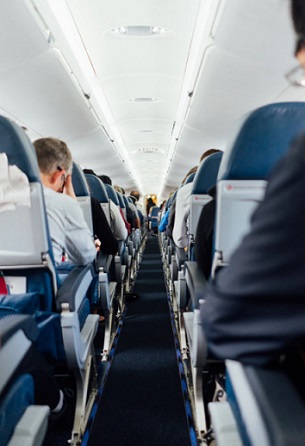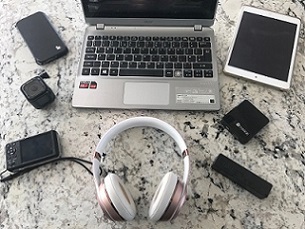 The last place you want a lithium battery fire giving off toxic smoke is in the confined space of an aircraft passenger cabin
The last place you want a lithium battery fire giving off toxic smoke is in the confined space of an aircraft passenger cabin
 An AvSax lithium battery fire mitigation bag
An AvSax lithium battery fire mitigation bag
 All these electronic devices are powered by lithium batteries
All these electronic devices are powered by lithium batteries
 AvSax lithium battery fire mitigation bags save the need for costly diversions and emergency landings
AvSax lithium battery fire mitigation bags save the need for costly diversions and emergency landings
A power bank caused a fire scare on a passenger plane flying from one European destination to another.
According to the Aviation Safety Network the incident happened on a Lufthansa plane flying from Frankfurt in Germany to Porto in Portugal when the power bank expanded and broke apart mid flight on Wednesday, March 6, 2024.
The crew quickly dealt with the power bank but firefighters were alerted and quickly went aboard as son as the plane touched down as scheduled.
The Aviation Safety Network reports: “Firefighters took possession of the power bank, secured it and transported it for safe storage and disposal. There was no fire or harm to customers or crew.”
Worryingly though this is the fourth lithium battery fire incident on a plane since February 19 with the others happening in the USA, Thailand and Hong Kong.
One passenger aircraft had to make an emergency landing and was then delayed for almost 24 hours after a laptop caught fire.
The Breeze Airways plane carrying 88 passengers was on a 2,500-mile internal US flight from Los Angeles to Pittsburgh in Pennsylvania on Friday, March 1, 2024 when the passenger’s laptop caught fire after going into thermal runaway.
The plane was about a third of the way into the flight and 150 miles from Albuquerque in New Mexico so the crew decided to divert there and descended to make an emergency landing while the crew extinguished the fire.
The incident will now be investigated by the Federal Aviation Administration in the USA which collates information on all lithium battery incidents on US planes or in US airspace and then publishes it.
The FAA recently revealed there were five lithium battery incidents in December 2023. Read more at https://avsax.com/news/lithium-batteries-spark-fire-scares-on-five-passenger-aircraft-in-just-one-month
In the other two incidents over the last few days a Thai AirAsia Airbus was flying from Bangkok to Nakhon Si Thammarat in southern Thailand on Saturday, February 24, 2024, when smoke began to pour from an overhead locker.
A passenger’s power bank had gone into thermal runaway and the crew acted quickly to douse the fire and put the device into a container so it could continue to its destination and land safely. No-one was hurt.
On Monday, February 19, 2024, a Royal Air Philippines plane flying from Caticlan in the Philippines to Shanghai in China diverted to Hong Kong after a passenger’s power bank battery went into thermal runaway, sending smoke spiralling through the cabin.
The plane was on the ground for two hours before continuing its journey.
The ever increasing number of lithium battery incidents on aircraft means that many airline operators now have thermal mitigation bags on board to deal swiftly and effectively with the problem before anyone is hurt, the aircraft is damaged or needs to divert and make an emergency landing.
The most widely used by far is the AvSax which is now on almost 17,000 planes operated by around 100 airlines and has been used in action dozens of times.
The AvSax won the Queen’s Award for Enterprise for its innovation in the UK – the highest award any business can achieve.
AvSax are made by UK company Environmental Defence Systems Ltd and its special projects manager Jessica Bailey said: “Four incidents happening in less than three weeks is certainly alarming.
“We suspect many other incidents are happening but regulatory authorities around the world simply don’t report them, apart from the Federal Aviation Administration in the USA, which means we don’t exactly know just how commonplace the problem of lithium battery incidents on planes is becoming.”
The reason AvSax is so popular among airlines is that it continually cools the overheating device while containing it.
The UK’s regulatory organisation the Civil Aviation Authority says: “Since the development of the International Civil Aviation Organization guidance on dealing with an in-flight battery fire, new products designed for use in response to lithium battery thermal runaway events have become available.
“Products which provide both a cooling and containment capability are typically more aligned to the existing ICAO guidance as when used they are filled with water or other non-flammable liquid to act as a cooling agent.
“After knocking down flames it could conceivably take just a couple of seconds for a personal electronic device to be placed inside a containment bag, allowing it to be moved to a place of safety.
“Passengers could then return to their seats, mitigating potential unrelated safety hazards such as injury in the case of severe turbulence. Equally, the effect on flight crew in carrying out their duties following an event on the flight deck would be minimised.”
For more information on AvSax go to www.avsax.com